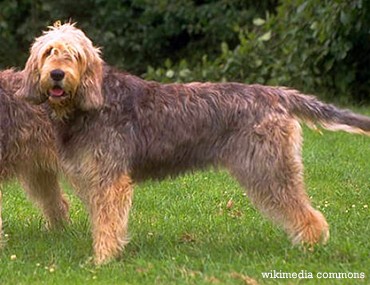Background
In 1775, in medieval England, fishermen were having trouble with river otters who were taking all of the fish. It was the Otterhound who solved their problem. The Otterhound was developed to keep the river otters at bay and to protect the fishing industry. Eventually otter hunting turned from a job into a sport.
Bad King John hunted with Otterhounds and Queen Elizabeth I was named the first “Lady Master of Otterhounds.” Currently there are only an estimated 1000 Otterhounds in the entire world and they are the most endangered breed in Britain.
The Otterhound was recognized by the American Kennel Club in 1909.
Sizing up
- Weight: 65 to 115 lbs.
- Height: 24 to 28 inches
- Coat: Silky, oily, soft undercoat and longer harsh outer coat
- Color: Combinations of white, grizzle, sandy, red, wheaten, blue
- Life expectancy: 10 to 15 years
What’s the Otterhound like?
The Otterhound is friendly but can be destructive at times, especially if he’s bored. He loves food so don’t be surprised if you come home to all your cabinets opened, trash cans knocked down and very full Otterhound. Some can even open refrigerators.
Otterhounds are naturally friendly but prefer the company of older children. They can be a little too rowdy for youngsters. With their deep low voice they can be incredibly loud and will be extremely excited to tell you all about their day.
The Otterhound is typically an easygoing hound but he can be a bit stubborn if not trained properly. Like most puppies, start training the day you bring him home. Praising, almost to the point of bribery, is crucial. Puppy kindergarten is also a good recommendation.
The Otterhound has a rough double coat which can be six inches long, but grooming isn’t as hard as you’d think it would be. A weekly brushing and a bath monthly will do the trick; however, you will have to clean his beard after eating to prevent odor and occasional leftovers.
Health
The Otterhound is generally a healthy breed but be on the lookout for any of the following:
- Hip dysplasia
- Arthritis
- Ear infections
- Gastric torsion
- Epilepsy and seizures
Takeaway Points
- The Otterhound can get destructive fast, so training early is a must.
- The Otterhound is more suitable for a household with older children.
- The Otterhound tends to follow his nose wherever it takes him so a fenced in yard is highly recommended.
- The Otterhound has a very deep and loud “hound voice” which may not be ideal for apartment living.
If you have any questions or concerns, you should always visit or call your veterinarian -- they are your best resource to ensure the health and well-being of your pets.
